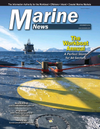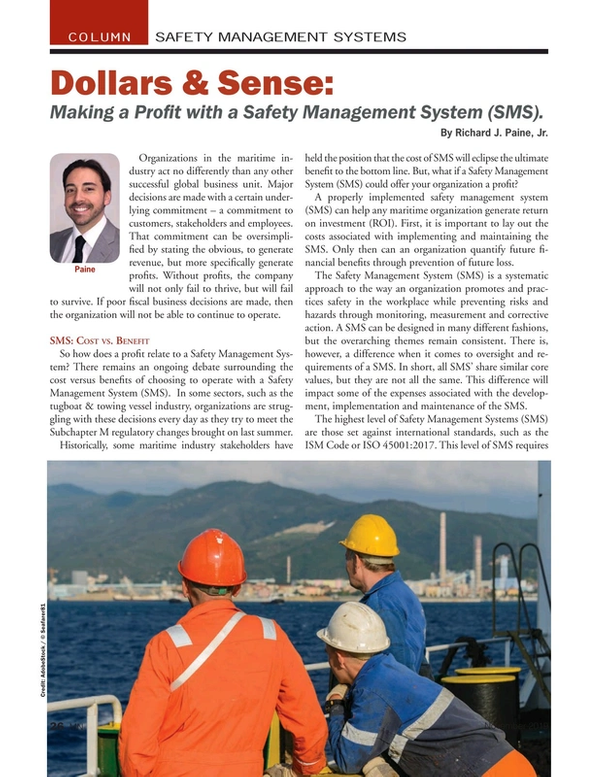
SAFETY: Dollars & Sense
Make a Profit with a Safety Management System (SMS).
Organizations in the maritime industry act no differently than any other successful global business unit. Major decisions are made with a certain underlying commitment – a commitment to customers, stakeholders and employees. That commitment can be oversimplified by stating the obvious, to generate revenue, but more specifically generate profits. Without profits, the company will not only fail to thrive, but will fail to survive. If poor fiscal business decisions are made, then the organization will not be able to continue to operate.
SMS: Cost vs. Benefit
So how does a profit relate to a Safety Management System? There remains an ongoing debate surrounding the cost versus benefits of choosing to operate with a Safety Management System (SMS). In some sectors, such as the tugboat & towing vessel industry, organizations are struggling with these decisions every day as they try to meet the Subchapter M regulatory changes brought on last summer.
Historically, some maritime industry stakeholders have held the position that the cost of SMS will eclipse the ultimate benefit to the bottom line. But, what if a Safety Management System (SMS) could offer your organization a profit?
A properly implemented safety management system (SMS) can help any maritime organization generate return on investment (ROI). First, it is important to lay out the costs associated with implementing and maintaining the SMS. Only then can an organization quantify future financial benefits through prevention of future loss.
The Safety Management System (SMS) is a systematic approach to the way an organization promotes and practices safety in the workplace while preventing risks and hazards through monitoring, measurement and corrective action. A SMS can be designed in many different fashions, but the overarching themes remain consistent. There is, however, a difference when it comes to oversight and requirements of a SMS. In short, all SMS’ share similar core values, but they are not all the same. This difference will impact some of the expenses associated with the development, implementation and maintenance of the SMS.
The highest level of Safety Management Systems (SMS) are those set against international standards, such as the ISM Code or ISO 45001:2017. This level of SMS requires third-party registration and oversight, typically provided by IACS classification societies and registering bodies. This requires annual office audits and vessel audits. Based on the size of the operation and navigating areas, this type of system may be a requirement.
Other domestically regulated management systems include Subchapter M Towing Safety Management System (TSMS) which applies to the tugboat and towing vessel sector. This also requires Third-Party Organization (TPO) oversight. There are currently ten USCG approved TPOs.
Other voluntary safety management systems are supported by industry associations such as Passenger Vessel Association’s (PVA) Flagship Management System or American Waterway Operators’ Responsible Carrier Program (RCP). Importantly, Safety Management Systems can be designed for any size operation or industry.
Safety Management Systems that require third-party oversight will be more expensive due to the registration process and ongoing audits throughout certification. The costs will be relevant to the size of the operation and fleet. A small, one boat operation might spend s much as $15,000 annually, whereas that cost for a larger operation could increase exponentially.
System Development: Recouping those Costs
The development and implementation of a SMS will vary by the type of SMS the operator selects. The greater the oversight, the greater detail and time needed for the system to be implemented. Most certification audits will require 90 days of record at a minimum to sit for a registration audit. The development phase of the SMS, including risk assessment, program and procedure development, and training can take anywhere from a few weeks to months to complete. The additional costs associated with developing and implementing the SMS can be quite modest, or as much as $50,000 or more.
Unless you are in the safety business, safety doesn’t generate revenue. Safety cultures and management systems prevent loss, and in many cases, significant financial loss. Hence, the properly implemented SMS, which addresses and mitigates risk, is a constantly evolving return on investment.
In actual practice, the most significant variable to the success of the operation, outside of equipment CAPEX, will always be the employees operating the equipment. Safety Management Systems place great emphasis on employee training and resources designed to minimize injuries in the workplace. Eliminating those injuries can all add up to a much more successful business. As an example, consider the following scenarios:
- A general crew claim with a minor injury and the crewmember goes to a reputable doctor can be resolved for $10,000 to $20,000.
- A general crew claim with a minor injury and the crewmember goes to a doctor that leverages the injury can cost upwards of $100,000.
- A ‘no liability’ passenger claim that involves an outside attorney can cost the vessel operator from $200,000 to $500,000 in investigation and defense costs.
- A ‘no liability’ passenger claim that involves simple out of pocket medical expenses is usually resolved for no more than $10,000.
- A Hull & Machinery claim can reach $300,000, not counting off hire time and loss of operating revenues on charter, etc.
Legal Defense
It doesn’t matter if the organization transports oil, containers, dry bulk, or even passengers; waterborne commerce can come to a halt in the courtroom. That’s because decisions made in the courtroom and even those cases that are settled outside the courts can have a 6-7 figure financial impact to the organization. However, a fully implemented SMS provides strategic benefits to an attorney.
Daniel J. Fitzgerald is Partner with the New York maritime law firm of Freehill Hogan & Mahar LLP, A Captain in the U.S. Coast Guard Reserve with over two decades of legal and marine safety and security experience, Fitzgerald told MarineNews, “Jurors and Judges want to know that shipping companies have spent time and resources implementing management tools aimed at avoiding marine casualties and personal injuries. People need to be educated and describing the management practices utilized by a shipping company helps to ‘personalize’ the corporate defendant.”
Beyond the corporate image, Fitzgerald agrees that the SMS is a proven benefit to the bottom line. “Companies with effective management systems have significantly less accidents and claims. Vessels are being operated safer than ever and losses at sea continue to decline. It’s this systematic approach to safety that continues to change the game.”
What’s the bottom line? Safety management systems (SMS) will always have upfront and reoccurring costs, but when that SMS prevents one incident, one injury, or one breakdown, the savings to the organization will be sizable. But, finances aside, safety shouldn’t be written in blood after the fact. Instead, make a profit for the organization by first investing time and resources as a way of preventing future losses. It turns out that Safety Management Systems do make sense – Dollars and Sense.
Richard Paine is a licensed mariner, certified TSMS & AWO-RCP Lead Auditor and DPA with over 20 years of maritime and auditing experience ranging from deep sea, tugs & towing, and passenger vessels. He is an alumnus of SUNY Maritime College in both undergraduate and graduate studies. A member of PVA’s Safety & Security Committee, he is currently is the Regional Director, HSSQE for Hornblower’s NYC Ferry & Statue Cruises operations. Richard can be reached at [email protected]
This article first appeared in the October 2019 print edition of MarineNews magazine.
Read SAFETY: Dollars & Sense in Pdf, Flash or Html5 edition of November 2019 Marine News
Other stories from November 2019 issue
Content
- BY THE NUMBERS: the OSV Markets page: 10
- INSIGHTS: Sean Fernstrum, President, R.W. Fernstrum page: 14
- SAFETY: Dollars & Sense page: 26
- ISO: Affordable & Reliable Workboat Comms page: 30
- BOATBUILDING: From Estonia with Love page: 54
- REGULATORY REVIEW: Subchapter M page: 60
- DECK MACHINERY: A Step Up in Safety page: 70
- Blount Boats: Ferries, Offshore Wind both Dominate Present, Future page: 72
- Digital Developments Continue Apace in the Workboat Space page: 76
- DOMESTIC DREDGING: U.S. Ports Require a Diverse Fleet page: 80
- Navigating the Rough Waters of Marine Certification page: 88


